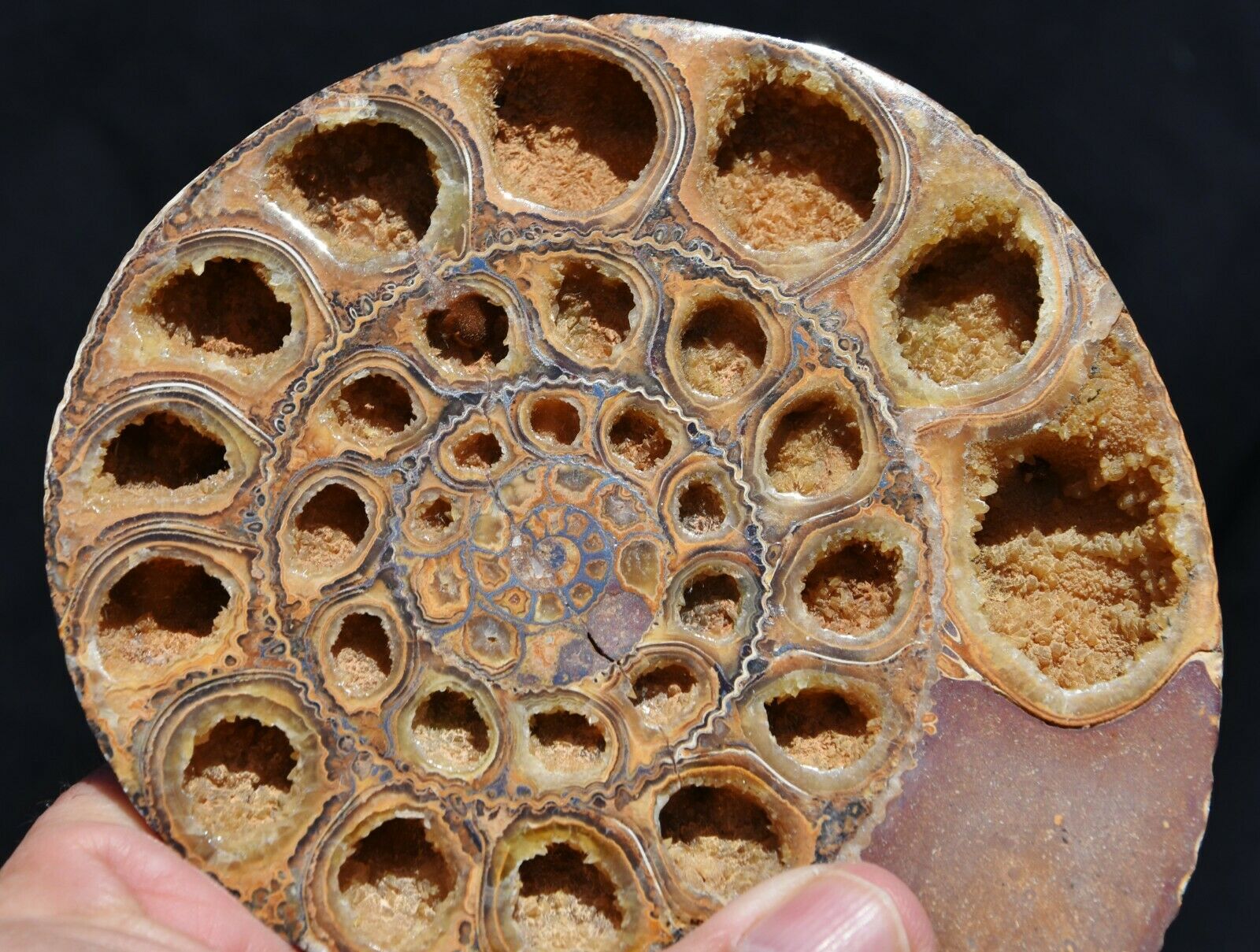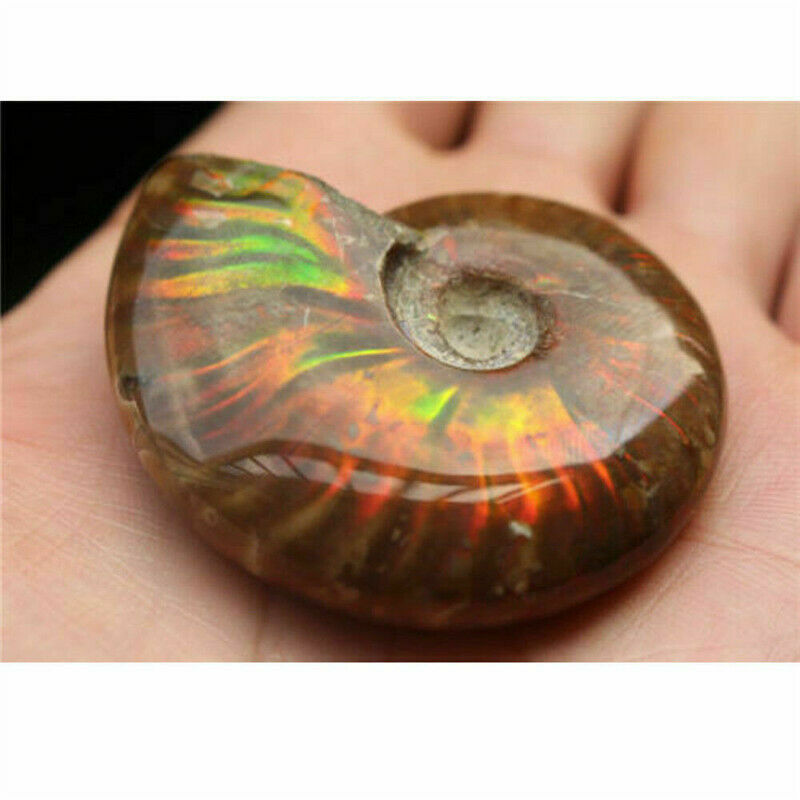-40%
RARE Perisphinctes Fossil Ammonite D-Shaped Crystal 132mm 5.3" 110myo 3794xx
$ 63.35
- Description
- Size Guide
Description
Imagine holding in your hand a 110 million year old fossil. Some ammonites are much older than that, up to 450 million years old. Even older than the dinosaurs. Oceans at the time were teeming with life. Predators were everywhere. And it was a live fast, or die hard world for the ammonites. In fact, ammonites closely resemble modern squids, octopus and the chambered nautilus. Ammonites were carnivores as well.Fossils were
once
found only in museums - NOW you can OWN one!!! You can hold in your hand a part of the ancient fossil record from the time the dinosaurs roamed the earth.
Description: Ammonite Pair Split, Cut and Polished
Perisphinctes - Less than 1% of Madagascar ammonites are this type. Ridges are on the back with a complete different growth pattern. The chambers are also more compact and of a different shape. Frequently one of the most brightly colored. On normal ammonites, the middle is thicker. On Perisphinctes the inner coils are smaller which is a rare occurance among ammonites. These always command a high price. (RARE) Just two in the last shipment.
Weight (lbs): 1.7#
Weight (g): 720 gram
Size (inches): 5.3" x 4.4"
Size (mm): 132mm x 113mm
Mine location:
Tulear, Madagascar
Item Number:
3794 y 29
Retail value:
95
----------------------------------------------------------
Facts about ammonites -
Closest living relative - Octopus, Squid, Cuttlefish and it's closest cousin the Nautilus.
First appeared - in shallow seas 450 million year ago.
Extinct - in a catoclysmic event in the Cretaceous, with the dinosaurs about 65 million years ago.
Began life - less than 1 mm in diameter. About the size of a period in this sentence. But they grew fast.
Females - reported to grow 400% bigger than males.
Shells - comprised of chambers growing as the ammonite did. Making 13 new chambers each year. The ammonite lived in the last section, called the living segment.
Medieval Europe - Ammonites were thought to be petrified snakes. They were called "snakestones" or "serpent stones". Ammonites were said to be evidence for the actions of St. Hilda and St. Patrick - who drove the snakes out of Ireland. In ancient times, traders would carve the face of a snake into the wide end of the ammonite fossil and sell them to the public.
The name Ammonite - comes from their spiral shape. The fossilized shells somewhat resembled tightly coiled rams' horns. Pliny the Elder (79 A.D. near Pompeii) called these fossils - ammonis cornua ("horns of Ammon") . Because the Egyptian god Amman was typically depicted wearing ram's horns.
-----------------------------------------------
Types of ammonites -
Cleoniceras
- These most colorful ammonites come from Madagascar, off the coast of Africa. Cleoniceras is the most common type in Madagascar. 99% of the ammonites found in Madagascar are this species, with a smooth shell and angled segments. The animal actually lived in the very last segments. Variations in price are due to color differences and how many crystal cavities (or open 'cave like' structures) in the segments. On average 110 million years old.
Perisphinctes
- Less than 1% of Madagascar ammonites are this type. Ridges are on the back with a complete different growth pattern. The chambers are also more compact and of a different shape. Frequently one of the most brightly colored. On normal ammonites, the middle is thicker. On Perisphinctes the inner coils are smaller which is a rare occurance among ammonites. These always command a high price. (RARE)
Fire ammonites
- Also from Madagascar. Notoriously hard to photograph. Fire ammonites have a gorgeous jewel red flash to them. In fact this jewel red flash is so hard to photograph that we have to take over 100 pictures, just to get 10 good photos. Similiar to opals in their brilliance. Occasional flashes of blue, green and purple can be seen. Fire ammonites look much better in person than in the photograph. (LIMITED QUANTITY)
Rainbow iridescent
- Running from blue to white in base color, iridescents have a multiple color personality all their own. These are hard to photograph as well. Stunning blue, green, red and pink can be seen as they are moved in the light. Not as hard to photograph as the FIRE RED, but still hard to photograph. Again these are found in Madagascar only rarely. (LIMITED QUANTITY)
Pyrite ammonites
- Pyrite actually replaces the animal shell. A very odd occurance. (Calcite replaces the animal shell in most of the other ammonites.) Pyrite ammonites are species Kosmoceras. Kosmoceras frequently have a opalized shell on the outside. Occasionally this shell is rainbow iridescent. Stunning colors of red, green, blue and other bright colors. In Russia, they use a chemical solution to remove the shell on one-half of the ammonite. This exposed the pyrite segments inside. These are only found in Russia, in the Volga River area. Most are around 165 million years old.
Orthoceras
- Straight ammonites from Morocco. Frequently found with round Morocco ammonites called goniatites. About 400 million years old, some of the oldest ammonites. (moderately common) Big ones are rare.
Goniatites
- Curved ammonites from Morocco. Small ones are moderately common. Large ones up to 12" are much rarer and in higher demand as decorator pieces. The reason? The wide ones frequently stand by themselves. Usually grey, black and white in color. Sometimes in earth tones. Goniatites are frequently 400 million years old, some of the oldest ammonites. (small ones moderately common, large are rarer - especially ones over 6")
UK ammonites
- We occasionally have Rainbow colored (2-3")
Psilocercy
from Dorset England. About 200 million years old. And small black & white
Promicoceras
from Lyme Regis, Dorset, which rarely exceed 1". We have a few golden black
Dactiloceras
from Whitby, UK. About 165 million years old. (VERY LIMITED QUANTITY)
On a recent trip to Germany - I was able to acquire a few
Orthosphinctes
from Malm gamma, Bischberg. Nice greenish yellow 2-3" ammonites on matrix. (LIMITED QUANTITY)
Check our other listings for these and other types of fine ammonites!!!
-----------------------------------------------
Madagascar Ladies Coop - Most ammonites come from Madagascar, off the coast of Africa. Madagascar has all the problems that that the African continent has. One way you and I can combat this is to buy our ammonites from a 'Ladies Coop'. This is where I get my ammonites. Not all dealers buy from this source. We will get to the 'ladies coop' in a minute.
A few facts about Madagascar - Average per capita income is 00 to 53 per year. With an average family size of 6.6.
That makes the average family income in Madagascar ,600 to ,000 per year. Enough for the basics, but not much else.
Imagine
trying to feed
your
family of 6-7 people with only 00 per year?
Madagascar families have hard working people, they don't want a 'hand out'. But folks, we can give them a 'hand up'. The men go out and do the digging and rough surface mining. Hot sweaty, back breaking work. The women at the 'ladies co-op' work together as a team. Splitting or cutting the ammonite down the middle with a diamond saw. Then polishing the inside to a high gloss and then polishing outside to show the shells' true variety. This can take up to 6 hours per ammonite.
Today 90% of the animals on Madagascar are found no where else. Even in ancient times the ammonites of Madagascar's shallow sea were unique. And no other local produces ammonites of such wide ranging colors. Of the affordable ammonites, Madagascar produces the best and most colorful.
Your purchase helps feed a family in Madagascar.
------------------------------------------------------------------------------------------------------------------------
Ebay's shipping calculator
does
not
always work correctly. The figure is closer to:
Combined Shipping:
USA
**
Worldwide** Canada**
usd = 1.2 euros
SMALL Flat Rate Box >.25 to .50# .95 .45 (11 +/- euro) .45
8-5/8" x 5-3/8" x 1-5/8"
M
>1/2# (.25kg) $ 6.13** .90 (13.3 euro)** 10.70cad**
1# (.50kg) $ 7.70 .50 (18.5 euro) 15.46cad
2# (1kg) .80 .50 (29 euro) 28.50cad
3# (1.4kg) .98 .00 (33euro) 32.00cad
4-10#* ( 1.8 -4.5kg) .95 .95 (37euro) 38.00cad
*limit to BOX size of 5"x12"x12" or 13x30x30cm , International limit is 20# or 9kg for Large Flat Rate Box and is strickly enforced by the US post office. International shipping can take 2 to 3 weeks.
Combined shipping - If you want combined shipping PLEASE email us.
WE have no way
of knowing when you are finished bidding. Ebay sends automatic invoices. Ebay
will charge the maximum shipping PER item, if I do not override the invoice.
So bid all you like, but let us know "You want combined shipping."
**These are "approximations" or best guess. I only charge actual shipping cost, so they may be a few dollars (euros) more or less than my guess.
Ebay calculation
- does not allow for variation of shipping boxes (the size and cost really varies). Plus packing peanuts, bubble wrap do make a difference in weight, so eBay calculations are
ALWAYS wrong.
My listing has a 'best guess calculation' from ebay.
I will only charge actual shipping.
Usually our guess is within a dollar or two on most shipments so we do not worry about it. (actually we 'undercharge' or charge too little 82% of the time.)
Stands
-are shown for display only and are NOT included in the auction. SORRY due to ebay's policies and hard to use invoice system we no longer sell the stands.
Repairs
- All fossils have some repairs. Being buried under tons of rubble tends to be rough. None comes out of the ground perfect and whole. Almost all fossils have repairs. One of the reasons I photograph the back is so that you can see the repair work that has been done.
Almost all of the fossils you see in a musuem have had some type of repair work done. Only tiny fossils have minimal repair work on them. The folks in Madagascar do a very professional job, however occasionally natural cracks are visible on the surface. This is part of the natural beauty of the fossil and not considered a defect. Simply hit 'supersize' on the picture to get a bigger view.



















